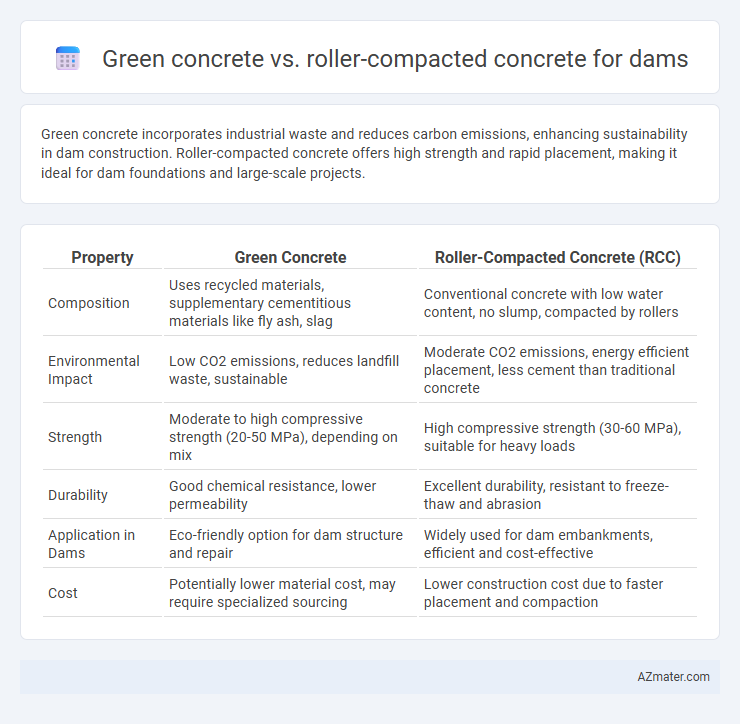Green concrete incorporates industrial waste and reduces carbon emissions, enhancing sustainability in dam construction. Roller-compacted concrete offers high strength and rapid placement, making it ideal for dam foundations and large-scale projects.
Table of Comparison
| Property | Green Concrete | Roller-Compacted Concrete (RCC) |
|---|---|---|
| Composition | Uses recycled materials, supplementary cementitious materials like fly ash, slag | Conventional concrete with low water content, no slump, compacted by rollers |
| Environmental Impact | Low CO2 emissions, reduces landfill waste, sustainable | Moderate CO2 emissions, energy efficient placement, less cement than traditional concrete |
| Strength | Moderate to high compressive strength (20-50 MPa), depending on mix | High compressive strength (30-60 MPa), suitable for heavy loads |
| Durability | Good chemical resistance, lower permeability | Excellent durability, resistant to freeze-thaw and abrasion |
| Application in Dams | Eco-friendly option for dam structure and repair | Widely used for dam embankments, efficient and cost-effective |
| Cost | Potentially lower material cost, may require specialized sourcing | Lower construction cost due to faster placement and compaction |
Introduction to Dam Construction Materials
Green concrete and roller-compacted concrete (RCC) are innovative materials revolutionizing dam construction, each offering unique sustainability and performance benefits. Green concrete incorporates industrial by-products like fly ash or slag, significantly reducing carbon footprint and enhancing durability, while RCC features a drier mix enabling rapid placement and compaction, leading to faster construction times and cost efficiency. Both materials improve structural integrity and environmental impact, making them preferred choices for modern hydraulic engineering projects.
Overview of Green Concrete
Green concrete incorporates industrial byproducts such as fly ash, slag, and recycled aggregates to reduce carbon emissions and environmental impact in dam construction. This sustainable material offers comparable strength and durability to traditional concrete while enhancing thermal performance and reducing water usage. Its eco-friendly composition makes it increasingly preferred for large-scale infrastructures like dams aiming to meet green building standards.
Understanding Roller-Compacted Concrete (RCC)
Roller-compacted concrete (RCC) for dams is a zero-slump concrete blend used for rapid construction and high structural strength, consisting primarily of cement, water, and well-graded aggregates compacted with vibratory rollers. RCC's low cement content and no slump improve durability and reduce cost compared to traditional concrete, making it ideal for large-scale dam projects needing minimal curing time. Green concrete emphasizes environmental benefits by incorporating industrial by-products to reduce carbon footprint, while RCC enhances construction efficiency and strength without compromising sustainability.
Environmental Benefits of Green Concrete
Green concrete significantly reduces carbon emissions by utilizing industrial by-products like fly ash and slag as partial cement replacements, lowering the overall cement content, which is a major source of CO2 in traditional concrete production. Its incorporation of recycled materials and enhanced durability minimizes resource depletion and extends the dam's lifespan, reducing the need for frequent repairs and rebuilds. Compared to roller-compacted concrete, green concrete offers superior sustainability through lower embodied energy and decreased environmental footprint during dam construction.
Structural Performance of RCC in Dams
Roller-compacted concrete (RCC) for dams offers superior structural performance due to its high density and low permeability, which enhances durability and resistance to cracking under load. Green concrete, incorporating recycled materials and industrial by-products, improves sustainability but may exhibit variable compressive strength and long-term durability compared to RCC. Structural integrity of RCC in dams is reinforced by optimized mix designs and compaction methods, ensuring high early strength and reduced thermal cracking crucial for large-scale dam construction.
Sustainability Comparison: Green Concrete vs RCC
Green concrete incorporates industrial by-products such as fly ash and slag, significantly reducing carbon dioxide emissions compared to traditional cement, making it a sustainable choice for dam construction. Roller-compacted concrete (RCC) offers a rapid placement process and lower cement content per cubic meter, contributing to reduced energy consumption and minimal environmental impact. While both materials enhance sustainability, green concrete excels in carbon footprint reduction, whereas RCC optimizes resource efficiency and construction speed in dam projects.
Cost Analysis and Economic Viability
Green concrete reduces overall project costs by utilizing industrial by-products like fly ash and slag, lowering material expenses and minimizing environmental compliance fees compared to traditional cements. Roller-compacted concrete (RCC), favored for dam construction, offers rapid placement and reduced labor costs due to its dry consistency and mechanized compaction, enhancing economic efficiency. While Green concrete excels in sustainability-related savings, RCC provides superior cost-effectiveness in large-scale dam projects through faster construction timelines and decreased formwork requirements.
Construction Techniques and Efficiency
Green concrete utilizes recycled industrial byproducts such as fly ash and slag, reducing environmental impact while maintaining strength through traditional mixing and curing methods. Roller-compacted concrete (RCC) involves a dry mix placed with heavy rollers, enabling rapid layering and compaction, significantly accelerating dam construction timelines. RCC's high placement speed and reduced formwork requirements improve construction efficiency compared to the slower curing and formwork dependency of green concrete.
Durability and Long-Term Maintenance
Green concrete incorporates supplementary cementitious materials like fly ash and slag, enhancing its durability through improved resistance to chemical attacks and reduced permeability, which minimizes long-term maintenance. Roller-compacted concrete (RCC) offers exceptional strength and abrasion resistance due to its dense, low-water content matrix, making it highly durable under heavy load and cyclic water pressures typical in dams. RCC's ease of placement and reduced curing times contribute to lower maintenance costs, while green concrete's environmental benefits complement its durability in sustainable dam construction.
Future Trends in Eco-Friendly Dam Construction
Green concrete, utilizing recycled materials and industrial by-products, significantly reduces carbon emissions in dam construction, aligning with future eco-friendly infrastructure goals. Roller-compacted concrete (RCC) offers rapid placement and durability, with advancements integrating supplementary cementitious materials to enhance sustainability. Emerging trends emphasize combining green concrete technologies with RCC methods to optimize environmental performance and structural resilience in large-scale dam projects.

Infographic: Green concrete vs Roller-compacted concrete for Dam
 azmater.com
azmater.com